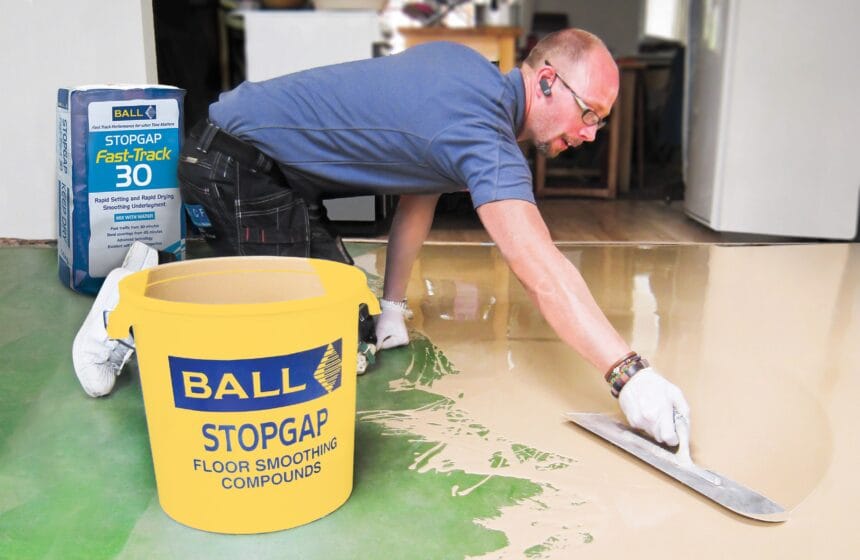Fast-Track Smoothing Compounds

Flooring contractors installing floorcoverings as part of a refurbishment will often find old adhesive residues upon the removal of floorcoverings. Additionally, installations frequently face increasing time pressures. Smoothing compounds are one product category that has seen particular advancements in order to help flooring contractors install floorcoverings as quickly as possible in such situations. F. Ball technical service officer John Green discusses the latest innovations.
Many recent developments have been intended to speed up the subfloor preparation process, to help flooring contractors under ever-increasing pressure to work to shorter timescales, without compromising on finished results, with fast-track, quick drying smoothing compounds.
Stopgap Fast-Track 30, the fastest-drying smoothing compound on the market is walk-on hard from just 30 minutes and is ready to receive floorcoverings in as little as 45 minutes after application. It is suitable for use over a wide range of subfloor types, including sand/cement screeds, concrete and waterproof surface membranes. In common with most other smoothing compounds, however, it requires the subfloor to be free of contaminants, including old adhesive residues, prior to application.
Adhesive residues
Another innovation that has sped up subfloor preparation is the formulation of smoothing compounds that can be applied directly over old adhesive residues, removing the need to spend valuable time mechanically removing them. Such products are formulated to minimise the stresses inflicted on adhesive residues as the smoothing compound sets, meaning it is able to maintain its integrity when applied to subfloors where these are still present.
In most cases, there is no need to apply a primer beforehand, saving further time and expense. The best of these smoothing compounds are usually able to accept foot traffic about one hour after application and are ready to receive new floorcoverings from around four hours later. They also have the benefit of allowing contractors to use the same product in situations where newly installed subfloors and areas with old adhesive residues present are next to each other.
New formulations
The latest advancements in technology have enabled F. Ball to create a quick drying, water-mix smoothing compounds that can be applied over old adhesive residues, Stopgap 1500. Such products have previously only been available in bag and bottle formulations.
The new smoothing compound is suitable for preparing a wide range of sound internal subfloors prior to the installation of new floorcovering and can be applied over bitumen, carpet tile tackifiers and ceramic tile adhesives, eliminating the need for mechanical preparation.
Just as with market-leading bag and bottle versions, the product is walk-on hard in as little as 60 minutes after application and ready to receive floorcoverings from just four hours. As a water-mix smoothing compound, no bottle is required, meaning less plastic waste is produced by the flooring industry.
Prior preparation
Before a smoothing compound is applied, contractors should begin any flooring installation by ensuring the subfloor is suitably sound, smooth and dry enough for the receipt of new floorcoverings. This may necessitate repairs to the subfloor or the removal of surface contaminants, excluding old adhesive residues when using a smoothing compound that can be applied directly over the top.
F. Ball recommends that a moisture test is then conducted to determine subfloor moisture levels. Where a moisture test indicates that the relative humidity (RH) level within the subfloor is above 75% (65% if wood floorcoverings are to be installed), a waterproof surface membrane will be required to prevent floor failure.
After these steps have been undertaken, the application of an appropriate smoothing compound is the final stage in the subfloor preparation process before new floorcoverings can be installed.
To find out more on F. Ball’s range of smoothing compounds can be found here: https://f-ball.com/en/smoothing-compounds/.